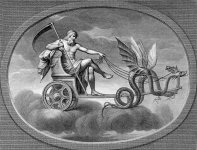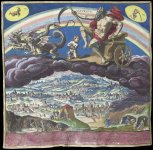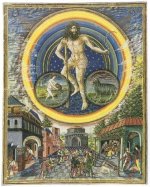What does the United States have to do with the Ancient Roman Empire? Allegedly there should be 2,000 years of time difference between the two. Today we do not see any new statues honoring Ancient Roman Gods being erected, than why were they so infatuated with the Ancient Rome 150 years ago? Why?
I just stumbled into the Great Seal of the State of California. It was adopted at the California state Constitutional Convention of 1849 and has undergone minor design changes since then, the last being the standardization of the seal in 1937.
The Seal incorporates the Goddess of War Minerva aka Athena, and
I understand that this seal has enough weird shenanigans with mysterious buildings, ships, a "gold prospector" digging a grave, etc. But what is this honed head doing on the shield of the Goddess of War while simultaneously being a centerpiece of the Seal of the State of California?

You can pick a Horned God of your own liking, for I have no idea which one it is. Other then that...
KD: I have only one question. What does any of this have to do with the United States of America?
I just stumbled into the Great Seal of the State of California. It was adopted at the California state Constitutional Convention of 1849 and has undergone minor design changes since then, the last being the standardization of the seal in 1937.
The Seal incorporates the Goddess of War Minerva aka Athena, and
- The seal shows the Roman goddess Minerva aka Athena , the goddess of wisdom and war, because she was born an adult, and California was never a territory; a California grizzly bear feeding on grape vines, representing California's wine production; a sheaf of grain, representing agriculture; a miner, representing the California Gold Rush and the mining industry; and sailing ships, representing the state's economic power. The word Eureka, meaning "I have found it", is the California state motto.
- The original design of the seal was by U.S. Army Major Robert S. Garnett and engraved by Albert Kuner. However, because of the friction then in existence between the military and civil authorities, Garnett was unwilling to introduce the design to the constitutional convention, so convention clerk Caleb Lyon introduced it as his own design, with Garnett's approval. Garnett later became the first general to be killed in the Civil War, where he served as a Confederate general.
- Original 1849 description, "Around the bevel of the ring are represented thirty-one stars, being the number of the States of which the Union will consist, upon the admission of California. The foreground figure represents the goddess Minerva aka Athena, having sprung full-grown from the brain of Jupiter aka Zeus. She is introduced as a type of the political birth of the State of California, without having gone through the probation of a Territory. At her feet crouches a grisly [grizzly] bear, feeding upon clusters from a grape vine, which, with the sheaf of wheat, are emblematic of the peculiar characteristics of the country. A miner is engaged at work, with a rocker and bowl at his side, illustrating the golden wealth of the Sacramento, upon whose waters are seen shipping, typical of commercial greatness; and the snow-clad peaks of the Sierra Nevada make up the back-ground. Above, is the Greek motto "Eureka," (I have found it,) applying either to the principle involved in the admission of the State, or the success of the miners at work. "
- The Seal was adopted in 1849 (followed by minor changes in 1883, 1891, and 1937)
California Seals
Note that this artistic rendition does not include the mysterious building or show the smoke and engine identifying the two-masted vessel on the far left as a steamship. Also missing is the fifth ship, which should be seen sailing through the break in the mountains, directly at the viewer. I understand that this seal has enough weird shenanigans with mysterious buildings, ships, a "gold prospector" digging a grave, etc. But what is this honed head doing on the shield of the Goddess of War while simultaneously being a centerpiece of the Seal of the State of California?
Welcome to California
Eureka, I found it...

Eureka, I found it...
KD: I have only one question. What does any of this have to do with the United States of America?




